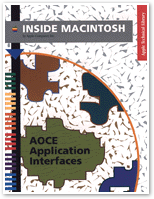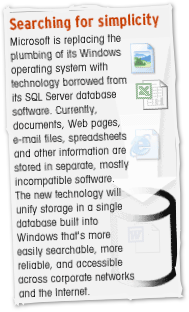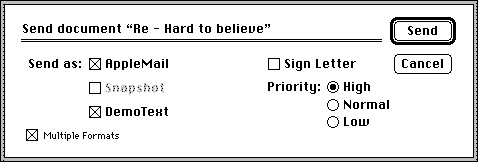
1990-1995: Apple vs. Microsoft in the Enterprise
A recent series of articles on Why Apple Will Change TV compared how Apple is poised for success in areas where Microsoft is currently failing. But circumstances are subject to change!
Just over a decade ago, Apple began facing serious legacy problems with its platform, with many parallels to today’s Microsoft. Examining Apple’s dramatic fall provides a series of notable platform lessons that no company should ignore.

Platform Death Match introduced the difficulty of launching a new platform and the work involved in maintaining one. This series looks at the historical march of computing platforms, to sort out why winners won and why losers lost. While the computing environment is always changing, the same basic rules are in effect today, and will shape the future developments between Mac OS X Leopard and Windows Vista.
Previous articles:

1990-1995: Apple vs. Microsoft in the Enterprise.
Apple's distant lead in graphical computing began eroding quickly in the early 1990's. Microsoft worked to improve its DOS based Window 3.0 while it also made incremental progress in developing the entirely new Windows NT operating system.
During The Rise of Windows, Apple merely entrenched in a rut of announced initiatives that failed to decisively deliver real progress or marketable products.
While Microsoft looked for new markets and targeted business users in particular, Apple seemed content to rely on its existing, established share of specific niche markets that offered large profit margins.
Moving Targets
In a dramatic reversal to the situation today, the Microsoft of the early 90's was struggling to deliver an entirely new platform that promised to provide real solutions to existing problems, and was based--in part at least--on open standards.
Under the code name Cairo, Microsoft described a cloud of features that eventually resulted in a series of products, although some took a decade to appear, some never did, and Cairo’s aim frequently changed to track new targets in the evolving tech landscape.
Meanwhile, Apple’s monolithic, proprietary Mac platform had hit the wall; the company began to experiment with various ways to combine the Mac user interface with the superior operating system technologies of Unix.
Along the way, Apple continued to expand the Mac user environment. In many cases, Apple tried to provide elaborate solutions to imagined future needs, and simply overshot the actual targets completely.
Differ'nt Strokes
The two companies could not have been more different. Microsoft established strong goals for its future Enterprise product lines and broadly advertised those plans; Apple tinkered with nebulous ideas for conceptual technologies, and kept most of its plans shrouded in secrecy.



Of course, both served very different markets with very different products. Still, there are relevant platform lessons to be learned from their mistakes and successes.
As a comparative example of how Apple and Microsoft each approached similar problems in very different ways, consider how each conceived and delivered its own messaging platform: Apple with PowerTalk, and Microsoft with Exchange Server.
In the mid 90's, the emergence of Local Area Networks began to cultivate new applications for computers. After file sharing, messaging was the next obvious new application for LANs; Apple and Microsoft each developed very different solutions for this need.
Exchange vs. PowerTalk
Microsoft's Exchange Server was announced around the same time that Apple delivered PowerTalk; both involved similar goals to build a new generation of workgroup email services.
Since the commercial Internet had not yet arrived, both PowerTalk and Exchange were designed prior to the arrival of the now standard SMTP email system. Microsoft's Exchange Server was intended to be based on open industry standards: X.400 messaging and X.500 directory services.
Apple's PowerTalk was an entirely proprietary system based upon AppleTalk. Rather than just delivering text messages, PowerTalk was conceived as a client side system for choosing, sending, and interacting with various things, including files, mail, fax machines, and printers. PowerTalk mirrored the rest of the elegant and richly engineered point-and-click Mac desktop environment, and promised to be the next great Mac advantage.
Apple's business model revolved around selling hardware, so their plans and motivations for messaging centered on sophisticated, high value client machines.
Apple didn't think the world was ready for dedicated servers to handle email, particularly within the company's own core markets of education users and graphic designers working in small workgroups.
Along those lines, PowerTalk didn't require a dedicated server; local Macs on a network were intended to exchange messages at regular intervals, whenever they found each other online.
Apple had already pioneered the concept of automatic network configuration and presence discovery services with AppleTalk networking and AppleShare file sharing; these features were reintroduced for modern IP networks under the name Bonjour a decade later.

Just as AppleTalk printers automatically appeared in the Mac Chooser without needing any setup or configuration, PowerTalk planned to extend messaging, security services, and everything else into a simple, elegant system that "just worked" like every other Apple product.
Any Mac application could add support for sending mail and attachments directly, just as easily as printing. PowerTalk sounded great in theory.
Notable platform lesson:
in theory, theory and practice are the same; in practice, they are not.
Snowballs in Hell
Apple's ability to deliver products was increasingly being hampered by a lack of product-oriented discipline. Rather than creating insanely great products designed to sell and enrich the company in ways that would foster further great developments, Apple gravitated into the position of a research lab full of engineers working on various projects that never seemed to materialize.
Apple's middle managers sought to prevent their pet projects from getting canceled, without any regard for the potential marketability of those products. In the typical fashion of corporate cube politics, they created fiefdoms of control over various projects, and then tied them together to create essential packages of functionality that would be hard to veto.
These projects snowballed into horrific disasters that were so complex they could never be completed, but which also contributed highly touted features that were tightly woven into Apple's increasingly widening strategies. That made them impossible to deliver but difficult to kill.

Notable platform lesson: undeliverable zombie projects have to be put down or they will simply eat up all the brains in a company.
The PowerTalk Disaster
PowerTalk was one of those snowballing disasters. It grew into the Apple Open Collaboration Environment, a suite of messaging technologies that picked up features as it rolled downhill: extensive foreign language support, digital signatures and encryption features, a centralized address book with a universal addressing system, and a protocol stack designed to accommodate virtually every existing messaging protocol and any others still to arrive, and an extensible information cataloging system.

The resulting suite of software was simply too much to run on existing Mac hardware, particularly when paired up with Apple's other gigantic snowball project, QuickDraw GX.
While software had been straining to keep up with hardware advancements in the late 80's, by the early 90's, Apple was delivering overarchitected software which was simply too much for the hardware of the time. Even for users with enough disk space and RAM to install PowerTalk, simply getting mail became a problem because individual mail items quickly ate up any remaining disk space.
Networking capacity was another problem for PowerTalk. The polling required to find other networked systems became a liability when working remotely over dial-up networks; systems would dial expensive circuits at regular intervals to attempt deliveries to remote PowerTalk clients.
Since PowerTalk saw only marginal use, it failed to ever become lean and refined, a classic problem for Apple's out of control software initiatives. By the time hardware was available to run PowerTalk and the rest of AOCE, the world was aligning behind a different set of goals and expectations for email.
Notable platform lesson: raw technologies don’t sell; finished products do.
The Advantage of Open Standards
Exchange Server followed a more mainstream client-server model that was closer in practice to what the commercial Internet began to deliver. Microsoft was able to make minor adjustments to connect Exchange Servers with Internet mail systems. By leveraging open standards, Microsoft could integrate with other industry players and found it easier to keep up to date with where the rest of the industry was heading.
PowerTalk, as primarily a peer to peer system, was so conceptually different that it didn't really fit into the Internet mail server model.
Apple eventually dropped PowerTalk, although a few of its associated ideas, such as a system wide keychain and address book, were salvaged and are still in use today in Mac OS X.
Notable platform lesson: it's much easier to work with the industry rather than against it.
A Matter of Time
In retrospect, it's convenient to compare Exchange and PowerTalk as if they were direct competitors; in reality however, the two products actually existed in entirely different epochs of computing.
Gursharan Sidhu, the lead engineer of Apple's networking efforts in the AppleTalk era, got started with PowerTalk in 1989. Apple was shipping it in 1993 as part of System 7 Pro, its attempt to sell a premium version of the Mac system software.
After failing to make any progress in getting AOCE adopted by Mac users, Apple gave up on PowerTalk in 1996 and turned their attention toward the emerging commercial Internet with Cyberdog.
Microsoft started talking about Exchange conceptually in 1991 as part of Cairo, but it didn't ship anything until 1996. Early versions of Exchange were complete crap, but Microsoft constantly refined the product, and Exchange adopters saw regular improvements in the late 90s.
Given that perspective, a direct comparison of the two products is meaningless; however, although PowerTalk and Exchange existed in very different time periods, comparing their different approaches to the same problem and how they were positioned can still provide valuable platform lessons:
1. Don't try to sell a futuristic product that doesn't quite work yet; instead, talk about it while selling as existing product that can compete in the current market. Good examples:
-
•Microsoft Mail sold while Microsoft talked about Exchange.
-
•DOS sold while Microsoft talked about Windows.
-
•Windows/DOS sold while Microsoft talked about NT.
-
•Mac OS 9 sold Macs while Apple talked about Mac OS X.
2. Don't attempt to fire conceptual ideas at an imagined market; instead, craft finished products that solve real problems and can support a sustainable market. Bad examples:
-
•Microsoft's Origami was a low powered laptop and a huge PDA wrapped up in one really ugly package.
-
•Apple's Newton was too big, too expensive, and too complicated to compete against the small, simple, and cheap Palm Pilot.
3. Ship a functional product and then constantly refine it; Real world use and years of ongoing refinement create enormous value for a product. Good and bad examples:
-
•Microsoft successful Windows and Office products were regularly updated (until about 2003).
-
•Apple's recent success with Mac OS X, iLife and Pro Apps comes from regular, progressive updates.
-
•Palm's failure came from dropping the ball in its ongoing software development efforts.
-
•Apple's failure with Copland came from years without delivering significant updates to System 7.
Apple: Not Down To Business
Apart from A/UX, the failure of PowerTalk left Apple without any Enterprise products, or even any serious workgroup server strategy.
Apple tried to build workgroup server products on top of Mac System 7, but again ran into significant legacy problems: the Mac system software was never designed to accommodate the needs and requirements of a dedicated server.
Apple desperately needed a better underlying platform to built upon, but was running out of time. Once a platform becomes commonly established, it is often very difficult to unseat. Because Apple didn't have a lot to offer larger businesses, the company concentrated its efforts on selling to its existing customer base: education and individuals.

Meanwhile, Microsoft continued to aggressively target business customers, and created new markets for Windows and the PC. I'll compare Microsoft's progress with efforts by Apple and NeXT in the next installments, and examine how those different motivations were reflected in the products each company delivered.
This Series










Thursday, October 12, 2006








 Bookmark on Del.icio.us
Bookmark on Del.icio.us Discuss on Reddit
Discuss on Reddit Critically review on NewsTrust
Critically review on NewsTrust Forward to Friends
Forward to Friends
 Get RSS Feed
Get RSS Feed Download RSS Widget
Download RSS Widget





